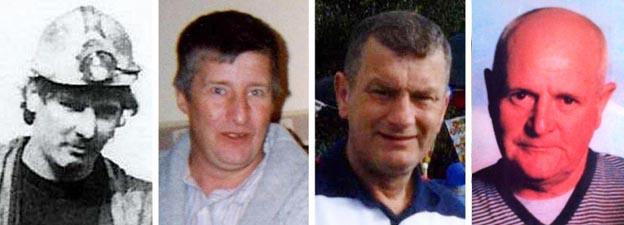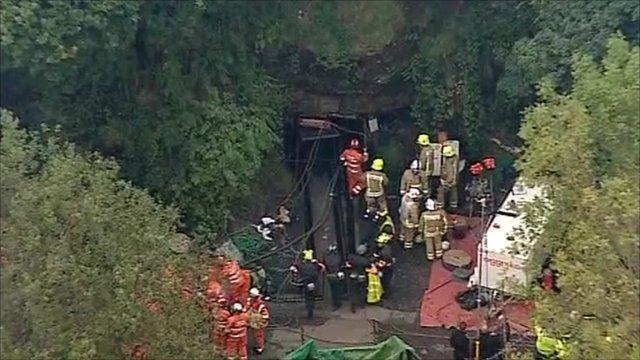Water flooded Gleision mine in six seconds, court hears
- Published

Garry Jenkins, 39, Philip Hill, 44, David Powell, 50, and Charles Breslin, 62, all died
The area of a Swansea Valley pit where three miners drowned as they tried to blast coal took just six seconds to fill with water, a court has heard.
A mines inspector told Swansea Crown Court the 200ft (60m) stretch of the Gleision mine was full almost immediately after an explosion.
The water gushed in at a speed of 21mph, he said.
Former pit manager Malcolm Fyfield and owners MNS Mining Ltd deny manslaughter charges.
David Powell, 50, Philip Hill, 44, and Charles Breslin, 62, were close to the coal face which was being blasted on 15 September, 2011, and died following the inrush of water.
Garry Jenkins, 39, was further away but was unable to escape.
'Concerned'
Peter Yoxhall, an inspector of health and safety for the Mines Inspectorate, told the court 17 tonnes of water emptied out of an old section of the mine near Pontardawe into the area where the men were working.
Giving evidence, he said after explosives were detonated water flowed at a rate of 9.4 meters per second - or 21mph - into the stall where the miners were.
"The time for the water to reach the bottom of the stall was six seconds," he said.
He also told the court 640,00 gallons of water were later pumped out of the mine.
He said following the tragedy rescuers were "concerned" about the efficiency of one of three pumps used to pump out the water.
The sump pump was only pumping out 46 gallons of water a minute as silt and debris regularly resulted in blockages which needed to be cleared.
Maps
In contrast, an electrical pump worked at a rate of 150 gallons a minute.
Jurors also heard how a geologist commissioned to laser scan the colliery after the disaster was warned he "didn't have a huge amount of money to play with".
Adam Anthony said he was "indirectly" told finances were an issue he should be aware of when assessing how much water may have been in the old mine workings before the tragedy.
Elwen Evans QC, defending Mr Fyfield, called into question the reliability of Mr Anthony's work.
In response, Mr Anthony agreed his calculation that there was around 3,000 square metres of water in the old workings the men blasted into was only accurate if the maps and information he was supplied with were reliable.
The court has previously heard that Mr Fyfield was one of seven men working in the mine at the time of the explosion and survived after he crawled out through sludge and dirt.
The trial continues.
- Published25 April 2014

- Published24 April 2014

- Published17 April 2014

- Published8 April 2014
